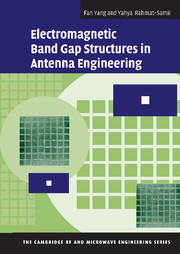Book contents
- Frontmatter
- Contents
- Preface
- Acknowledgements
- Abbreviations
- 1 Introduction
- 2 FDTD method for periodic structure analysis
- 3 EBG characterizations and classifications
- 4 Designs and optimizations of EBG structures
- 5 Patch antennas with EBG structures
- 6 Low profile wire antennas on EBG ground plane
- 7 Surface wave antennas
- Appendix: EBG literature review
- Index
- References
7 - Surface wave antennas
Published online by Cambridge University Press: 06 July 2010
- Frontmatter
- Contents
- Preface
- Acknowledgements
- Abbreviations
- 1 Introduction
- 2 FDTD method for periodic structure analysis
- 3 EBG characterizations and classifications
- 4 Designs and optimizations of EBG structures
- 5 Patch antennas with EBG structures
- 6 Low profile wire antennas on EBG ground plane
- 7 Surface wave antennas
- Appendix: EBG literature review
- Index
- References
Summary
The concept of surface wave antennas (SWA) was initiated in the 1950s [1–2] and numerous theoretical and experimental investigations have been reported in the literature [3–10]. To support the propagation of surface waves, a commonly used structure in SWA designs is a corrugated metal surface. However, the corrugated structure is thick, heavy, and costly, which may limit the applications of surface wave antennas in wireless communication systems.
In this chapter, novel surface wave antennas are presented. Compared to traditional SWA designs, surface waves are now guided along a thin grounded slab loaded with periodic patches, resulting in a low profile conformal geometry. In contrast to the previous wire-EBG antennas or patch antennas that radiate to the broadside direction, the proposed SWA achieve a monopole-like radiation pattern with a null in the broadside direction. The low profile SWA is more attractive than a traditional monopole antenna that is a quarter-wavelength high.
A grounded slab loaded with periodic patches
Comparison of two artificial ground planes
We start with analyzing a complex artificial ground plane, which will be subsequently used in surface wave antenna designs. Figure 7.1 shows two artificial surfaces: a mushroom-like EBG surface and a grounded dielectric slab loaded with periodic patches. In the latter structure vertical vias are removed, which results in different surface wave properties in the two ground planes.
To compare the electromagnetic properties of these two structures, the finite difference time domain (FDTD) method is used to simulate their performance [11–12].
Information
- Type
- Chapter
- Information
- Electromagnetic Band Gap Structures in Antenna Engineering , pp. 203 - 237Publisher: Cambridge University PressPrint publication year: 2008
References
Accessibility standard: Unknown
Why this information is here
This section outlines the accessibility features of this content - including support for screen readers, full keyboard navigation and high-contrast display options. This may not be relevant for you.Accessibility Information
- 1
- Cited by
